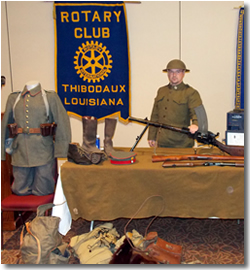Thibodaux Rotary Club | Ben Bernard “What They Saw In WW1”
November 13, 2012
By: Ken Gros
 Ben Bernard returned to the luncheon Tuesday with another interesting edition of “What They Saw” – World War I. He gave us a very brief history of the war and once again with the help of uniforms, equipment and weapons painted a portrait of the ordinary American and German soldiers.
Ben Bernard returned to the luncheon Tuesday with another interesting edition of “What They Saw” – World War I. He gave us a very brief history of the war and once again with the help of uniforms, equipment and weapons painted a portrait of the ordinary American and German soldiers.
For those who missed Ben’s previous presentations, “World War II – The German Soldier” and “What they saw – Vietnam”, Ben is a native of Cut Off and now lives in Thibodaux with his wife Lara and son Logan. He is a sales representative from Hyundai of Houma and Living Historian.
Ben is a historian and teaches through living reenactments for the National World War II Museum in New Orleans, Regional Reenactments, and visiting area schools teaching children about the life of the soldier in wars from the American Revolution, the Civil War, Vietnam and everything in between.
Ben has appeared in several History Channel programs based on World War II and the Vietnam War and assisted with the development of World War II Video games such as the popular “Call of Duty”. Ben’s grandfather was a Major in the Korean War and he became interested in war history at an early age. Ben has spent many hours with our fighting soldiers gaining an understanding of how war feels, and what is life really like for the men on the front lines.
Previously, Ben stressed the importance of detail, no matter how small, for reenactments to be successful. Participants “become” the soldier they are portraying and the more realistic the presentation the more informative it is.
Ben gave us a brief history of World War I. It was the first “Global War” and was different than any other conflict ever seen. It was a complicated war. Multiple nations were involved and were assembled in two opposing alliances, the Allies (France, Britain and Russia) and the Central Powers (Germany, Austria-Hungary and Italy).
America entered the war with the Allies in 1917 and fought until it’s conclusion in 1918. New technologies including aircraft, tanks, machine guns and chemical weapons were used. Because of these advancements in technology – and lethality of the new weapons, World War I was one of the deadliest conflicts in history.
Although both sides had plenty of new, impressive weapons, the soldiers in the field looked pretty ordinary. Ben was outfitted as an American GI or “Doughboy” including his brown wool uniform, low booties and a soft hat. He also donned a typical knapsack with usual implements including blankets, shovels and mess kits.
He explained how surprisingly, countries were just beginning to realize it was important for their fighting men to be comfortable in battle. GI’s standard rifle was the Springfield 1903 bolt-action 30-06. Select GI’s were issued the Winchester 1897 12-gauge shotgun which was very effective for trench warfare, however those who wielded it were shown no mercy if they were captured. Ben also showed us a standard issue “turtle shell” steel helmet with a crude camouflage pattern.
Next up was the German soldier. As usual the Germans appear to have one the fashion war. They donned a field grey wool uniform, leather boots with hobnails and a steel stahlhelm helmet – affectionately dubbed the frankenstien helmet by the allies because of two studs on its sides for attachment of a steel shield.
The helmets continued to be used throughout World War II. Soldiers used the Gewehr G-98 bolt-action mauser – the predecessor to the famous K-98, 8mm. Similar to other wars, the quality of uniforms and equipment was diminished by the end of the war as resources became scarce. Ben tried on a crude German gas mask; a grim reminder of the brutality of war.
When asked which soldier he prefers to reenact, Ben said the German soldier and went on a long explanation of why. I think it’s because the Germans seemed to have cooler toys than the Americans. Thank you Ben!
